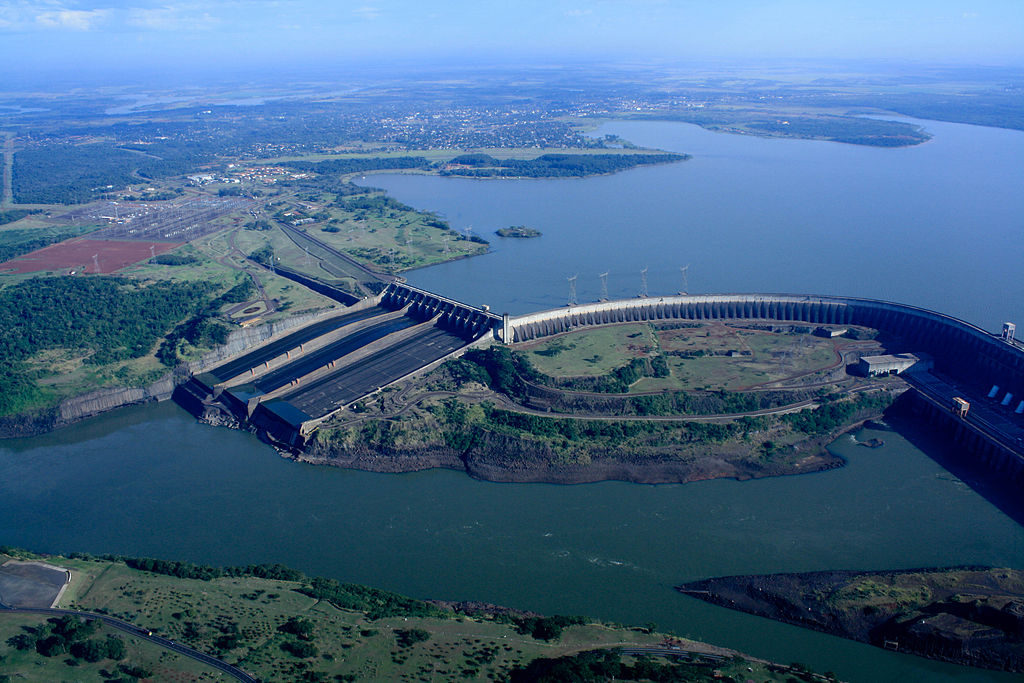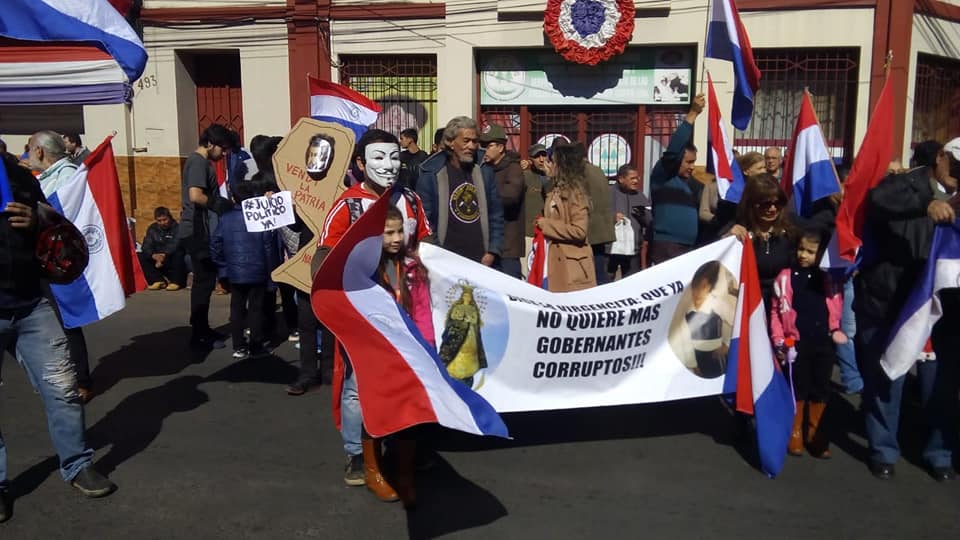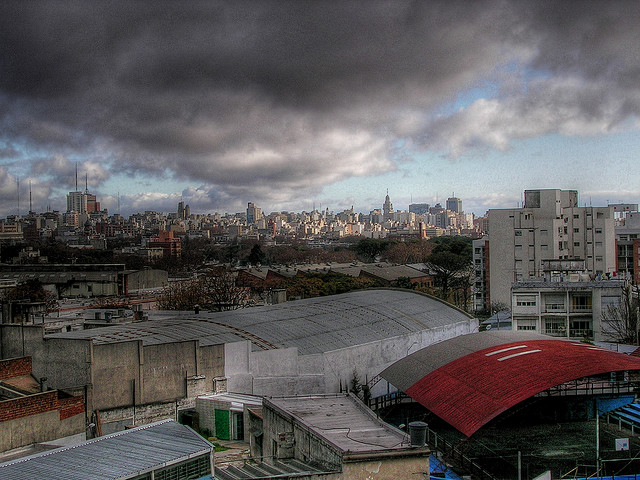
Dispatches, Features, Paraguay, Southern Cone
The Dam that (Almost) Brought Down Paraguay’s President
August 13, 2019 By AlannaElder
The past two weeks have brought Paraguayans a political earthquake and a crowd of new household names, all connected to a bilateral energy deal signed with Brazil in May and kept under wraps until late July. Since the public learned the terms of the agreement, four top Paraguayan officials have resigned and the senate nearly impeached President Mario Abdo Benítez and Vice President Hugo Velázquez.
Although Brazil agreed to scrap the deal and restart negotiations, Abdo Benítez and Velázquez are still fielding accusations of treason and the political fallout from the deal, rooted in 50 years of tension over the world’s second-largest dam. The dam straddles the border between Brazil and Paraguay and operates under the company Itaipu Binacional, a sort of state-within-a-state run by directors from both countries. This summer’s scandal unfolded on top of a long history of inequality between Brazil and Paraguay, turning a closet shift in energy payments into a symbol of national betrayal.
By requiring Paraguay’s National Energy Administration (ANDE) to buy more expensive electricity from the dam, the deal would have raised ANDE’s costs by at least $250 million between now and 2022, according to former ANDE head Pablo Ferreira. The negotiators also capped the amount of energy ANDE could contract and threw out a clause that would have allowed ANDE to sell Paraguay’s excess electricity directly to the Brazilian market at a higher price than what it receives now. Ferreira saw the final deal on July 4, about six weeks after both ambassadors had signed it and left his job on July 24. His resignation and refusal to comply with the terms of the new agreement raised the tenor of the debate over how to share the Itaipu dam.
For many Paraguayans, the agreement represented a step backward from terms reached in 2009 and a return to the systemic corruption that gave rise to the dam during the country’s dictatorship in the late 20th century. Nearly 50 years after it was built, the dam is still central to criticisms of the former dictator Alfredo Stroessner’s Colorado Party, which controls Paraguayan politics to this day.
“The citizenry is indignant over all of the theft that Itaipu represents on a historical level,” said environmental engineer Guillermo Acucharro. He is a spokesperson for a campaign called Ñane Mbae Itaipu, which means “Itaipu is ours” in the Indigenous language of Guaraní. “The Paraguayan people know, at least for this society, Itaipu was a scam and that the government of Mario Abdo wanted to carry out a negotiation behind closed doors.”
A Dictators’ Agreement
The Itaipu Dam was born out of a border conflict between Brazil and Paraguay nearly 100 years after the devastating Triple Alliance War ended, establishing the Paraná River as the national boundary. In the mid-1960s, the military dictatorships of both countries pressed toward the Saltos del Guaíra waterfalls (Sete Quedas for Brazilians), hoping to take advantage of the water resources that plunged 375 feet. Composer Phillip Glass created a tribute to the falls and the engineering marvel that replaced them when the two governments decided to build the dam together, signing the Itaipu Treaty in 1973 and founding Itaipu Binacional the following year. Brazil’s state utility Electrobras provided the largest loan to build the dam, which began production in 1984 but was not fully completed until 1991.
One significant trade-off of the two countries’ cooperation was that Stroessner allowed Brazilians to move into the agricultural lands of eastern Paraguay. This set the conditions for the predominance of land-holding Brazilians and their descendants, who now control Paraguay’s top export, soy. In other words, the act that preceded the dam paved the way for two primary examples of how Brazil has utilized Paraguay’s natural resources – land and electricity – in some cases impeding on national sovereignty.

The Itaipu dam straddles the border between Brazil and Paraguay and operates as a sort of state-within-a-state run by directors from both countries. (Photo by International Hydropower Association via Wikimedia Commons)
The 1973 treaty established that each country would own half the energy produced by Itaipu, but Paraguay consumes less than 10 percent, passing the rest to Brazil. The larger nation has always paid less than market value for that ceded electricity. Since the dam began operation in 1984, Paraguay has helped to fuel industrial development in São Paulo and elsewhere for a set compensation rate. Between 1984 and 2018, Brazil underpaid its neighbor by about $75.4 billion, according to economist Miguel Carter. Under different rules, Paraguay could have earned nearly twice its current GDP from Itaipu alone.
Critics argue that on top of the lost investments their government could have made to education, health and infrastructure, Paraguayan users have been overpaying for electricity. Even though the country has only used a fraction of the energy churned out by the dam over the years, consumers are still paying back construction debt, which makes up more than half of their electricity bills. Critics like renowned Paraguayan engineer Ricardo Canese and Columbia University economist Jeffrey Sachs say Paraguay has likely already met its obligations.
The debt payments will end in 2022, in time for the two countries to finish renegotiating a section of the 1973 treaty that governs energy distribution and pricing. The 2023 negotiation is crucial for those who want Paraguay to get more from its share of the energy. This year’s fumbled agreement appeared to point in the opposite direction, enraging critics of Itaipu’s legacy.
To critics like Acucharro of Itaipu Ñane Mbae, another key problem is that Itaipu Binacional operates outside the legal system of either country, which he says has made it difficult to control.
“The sector of elites within the Colorado party always used hydroelectricity to pay political favors,” he said. “Itaipu contributed to strengthening the dominant class of the country from the moment they signed the treaty.”
The dam represented how Stroessner’s regime pursued development for the benefit of a few: the benefactors of construction deals, as well as the engineers and employees of the new binational company. Zona 1 of the Paraguayan border town Ciudad del Este bears this legacy with its parks and guarded houses, a far cry from poorer parts of the city.
Paraguayans have been concerned about how the dam might weaken the country’s sovereignty since the earliest stages of the project. In the 1970s, students, led by Ricardo Canese and other young engineers, organized around questions such as where to put the turbines and what frequency of electricity would be generated. This July, engineering students from the Universidad Nacional de Asunción were once again leading the demands for the nation’s “energy sovereignty.”
Canese had remained a critic of Itaipu and finished his schooling in Holland, after Stroessner’s police forced him into exile in 1977. In 2008, the engineer joined the government of leftist President Fernando Lugo to help him fulfill a campaign promise: improve the rules of Itaipu for Paraguay. The team managed to triple the compensation payments Electrobras made to Paraguay from $120 million to $360 million per year.
Lugo’s Brazilian counterpart and political ally, Luiz Inácio Lula da Silva, made other important concessions that year, allowing Paraguay to sell to outside countries after 2023 and agreeing to a debt audit by Paraguay’s comptroller general. One key change gave ANDE the right to sell to private companies in the Brazilian market “as soon as possible,” Canese says, instead of only ceding energy to state-run Electrobras at a lower rate, but the new policy was never implemented.
“We were about to get it when the coup came in 2012, and now the ousted president of ANDE proposed it and it cost him the position,” Canese said.
Lugo’s election had broken a 60-year streak of Colorado Party rule, but his presidency reached a sudden end. After a land conflict resulted in the death of 11 campesinos and six police officers, his political rivals launched impeachment proceedings supported by the country’s powerful agribusiness lobby. After a year under Liberal Vice President Frederico Franco, Paraguay returned to Colorado control in 2012. The current president, Mario Abdo Benítez, is the son of dictator Stroessner’s personal secretary. Before winning the 2018 election on a platform of social conservatism, he studied in the United States, walked with Stroessner’s coffin at his funeral and founded a wing of the bulky Colorado Party with the dictator’s grandson.

Paraguayan President Mario Abdo Benítez shakes hands with Brazilian President Jair Bolsonaro in March. (Photo by Palácio do Planalto via Wikimedia Commons)
Canese worries the right-wing governments of Abdo Benítez and Brazilian president Jair Bolsonaro are undoing Lugo and da Silva’s contributions, which he says “restored some equity in the relationship after the asymmetric era of dictatorships—the Brazilian sub-empire, we said in Paraguay.”
“That’s what Bolsonaro wants now, as stated publicly, to go back to that time when Paraguay was almost a Brazilian colony,” Canese wrote in an email.
Bolsonaro has praised both Brazil’s and Paraguay’s military dictatorships. The controversial leader drew criticism in February when he stood next to the dam and honored Stroessner’s “vision.” Itaipu has become center stage for Paraguayan frustrations over their leaders’ approach to Brazil, and the feeling that their country’s resources are being sold out from under them. Bolsonaro’s administration approached Paraguay earlier this year, pursuing higher prices for ANDE and lower costs for Electrobras. Especially for critics of the ruling Colorado Party, Abdo Benítez’s concession amounted to the latest “surrender” of Paraguayan sovereignty.
A Political Crisis
Former ANDE head Ferreira has accused Brazil of financial extortion for its tactics in bringing Paraguay to this year’s talks, and Canese agrees.
“There never should have been a negotiation,” Canese wrote. “[Brazil] stopped paying Itaipu in February of 2019, defunding it and obliging it to negotiate on its terms and against everything that was agreed upon before.”
The new agreement that sparked calls to impeach Abdo Benítez reached national attention on July 24, after Ferreira turned in his resignation. On Twitter, Abdo Benítez welcomed former finance minister Alcides Jiménez to Ferreira’s vacated position that same day, writing, “We wish him the best!” Within days, the deal Jiménez was ready to support had become radioactive, with citizens and politicians condemning its terms, as well as the secrecy under which it had been negotiated. The senate called an extra session. Protesters toilet-papered the home of José Alberto Alderete, the Paraguayan director of Itaipu Binacional. Abdo Benítez accepted Alderete’s resignation along with those of Jiménez and two other top officials involved in the negotiations: the chancellor and the ambassador to Brazil.
Brazilian negotiators have argued that it is the other company that contracts with Itaipu—Electrobras—that had been getting the raw deal because power is cheaper on average in Paraguay. A change in the distribution of pricier versus less expensive, “surplus” energy is what Ferreira said would result in $250 million in extra costs for the utility, which already struggles with losses from poor infrastructure.
There appeared to be nothing in the original deal that could be construed as an advantage for Paraguay. In a speech on July 25, Abdo Benítez claimed this would make the country appear “serious” in future negotiations—“a country that does not need anyone’s crumbs”—and promised rates would not increase in the next two years. He has since said in a radio interview that he believes the deal was a mistake and “did not know the extent or scope of each point.”
Just a week after Ferreira’s resignation, opposition parties in Paraguay’s senate prepared to impeach Abdo Benítez and Velázquez, with the blessing of Honor Colorado, a faction of the leaders’ own party. The day after the impeachment threat, Abdo Benítez’s administration managed to win over the dissident Colorado members, avoiding an ouster just before the one-year anniversary of the president’s inauguration.
But WhatsApp messages published by Paraguayan newspaper ABC Color on Aug. 5 renewed calls for a political trial, suggesting that Ferreira had warned Abdo Benítez about the price changes desired by Brazilian negotiators. The president urged him not to show his misgivings publicly, warning that it would weaken Paraguay’s position. Since the leak, along with new evidence against his second-in-command, protesters and opposition lawmakers have continued to push for impeachment, a goal made more challenging by the Colorado Party’s decision to stand together.

Paraguayans protested against the Itaipu agreement in Asunción in early August 2019. (Photo provided by Itaipu ñane mba’e)
Other messages between Ferreira and a lawyer claiming to represent Velázquez suggested that the vice president was trying to intercede in the negotiations on behalf of the private Brazilian company Leros Comercializadora. The lawyer, 27-year-old Jose Rodríguez Gonzalez, also suggested in the chats that Leros had ties to Bolsonaro. Rodríguez has since testified that he was not speaking on behalf of Velázquez, but only trying to get Ferreira’s attention.
The Public Ministry is hearing testimony from both leaders as well as requesting records and messages from phone companies, while Canese and other critics remain suspicious.
“Abdo gives in to Bolsonaro because that is how they do business together,” Canese wrote in a message, “above all, in the sale of energy for hundreds of millions of dollars with friendly companies.”
Future Negotiations
For his part, Bolsonaro has said since the scandal that his government is “willing to do justice on this issue of Itaipu” and “avoid problems” for Abdo Benítez. The two countries are working on a new agreement, which could be finished as early as next month, while they continue to prepare for renegotiations of the 1973 treaty. The Brazilian leader said he does not intend to “give in” to Paraguay, but instead to discuss “small deviations” during the 2023 talks.
As Duke anthropologist and Itaipu expert Christine Folch asserts in an explanatory video, Brazil’s primary goal is to secure cheap energy to finance its industrial sector. She claims the best option for Paraguay is to invest in its electric infrastructure now in order to diversify its economy.
“Today, the Paraguay half of Itaipu produces enough electricity to meet the needs of three Paraguays,” she added. But since Paraguay’s energy demand is increasing, the country will not always have extra to sell. “This surplus has a time limit that makes it very important to use the surplus today.”
Folch’s research team estimates that Paraguay has until 2035 at the latest before it catches up to Itaipu’s production.
Canese, the Paraguayan engineer, is also pushing for better investments of energy revenue. “Electrical income should be a tool for development, not ‘profiteering,’” he wrote in an email. “Quality employment, value-added quality, that should be the goal, as well as sustainability.”
In a book published earlier this year, Canese argues for getting a better deal on Paraguay’s share of electricity from Itaipu as well as Yacyreta, shared with Argentina, and using that money to improve the electric system and attract industries that will provide jobs. Right now, much of the $750 million annual tariff goes toward local and national government entities, filling in the gap left by Paraguay’s exceptionally low tax rate.
Acucharro and the campaign Itaipu Ñane Mbae want the two countries to annul the 1973 treaty altogether and replace it with better terms for Paraguay.
“We recognize that, on the one hand, it’s a radical position, but we want to solve the root problem and not receive crumbs like always,” he said.
Both the recent scandal and the coming negotiations are changing the way Itaipu is debated in Paraguay, from exchanges between party elites to the kind of controversy that can threaten a presidency.
This article was co-published with the North American Congress on Latin America (NACLA).





